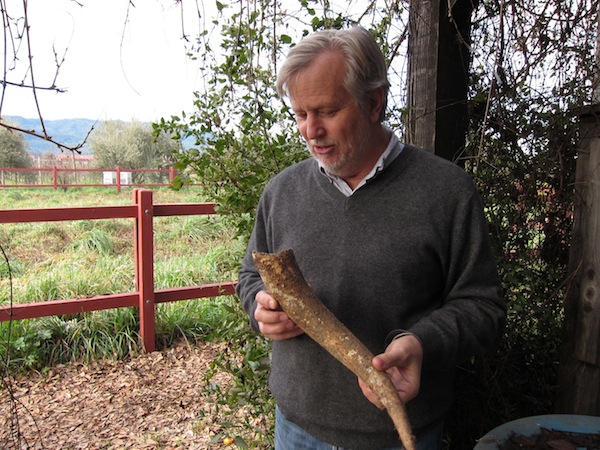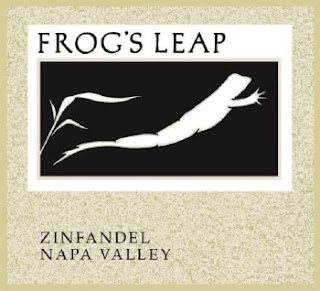Frog’s Leap Zinfandel & whatever he’s having
 |
| Frog's Leap founder/grower/winemaker John Williams |
“Times fun when you’re having flies,” was the motto at Frog’s Leap when they first burst upon the persnickety Napa Valley scene in 1981. They're going stronger than ever, even long after the departure (in 1992) of founding partner Larry Turley, who went on to further glory (only the most prestigious producer of Zinfandel and Petite Sirah in the country).
Original winemaker/proprietor John Williams has remained. Mr. Williams has been growing his grapes organically long before it was hip to be green. You can say he was “green” before it was the new black. Yet even after all these years, the only hint of environmental consciousness on the label of any Frog's Leap bottle are the words, discreetly printed, “responsibly farmed.” The wines sell because of their quality; and, of course, sense of "fun."
"Responsibly farmed" for Williams means it makes sense to provide organic matter to establish the healthiest possible soil environment for roots to dig deep, leaves to photosynthesize, and grapes to ripen well, while reflecting the quality of that soil. Sort of that circle of life thing.
This also explains the style and quality of the 2006 Frog’s Leap Napa Valley Zinfandel (about $27), which makes it something of an anti-Zin (not, mind you, anti-Turley, because Larry Turley's wines also stick to strictly organic farming practices). That is to say, this is not a “monster” Zin, gushing from the bottle with “gobs of fruit,” scraping the ground with knuckles of tannin, carrying two-by-four oak lumber and able to leap several barns at a single bound. If you're looking for that, you're in the wrong place, my friend.
What a Frog’s Leap Zinfandel is is a red wine of flourish and finesse, pep and pepper, silk and lace, motion not meat; beginning with its plush, black and boysenberry nose tinged with vanilla and clove, and then continuing with deliciously vibrant, smoothly textured flavors of the same that whisper sweet nothings on the palate rather than deliver crushing blows.
In the olden days (1970s) when I started in the business, they used to call this a claret style of Zinfandel. Of course, I haven’t heard anyone say “claret” since Alistair Cooke hosted Masterpiece Theater, but what that basically means is that like the red Bordeauxs of old, this is a Zinfandel that personifies terroir (i.e. sense of place) and balance, as opposed to pure Zinfandelishness. It tastes like a vineyard or region, not grapes.
 |
| "Claret," that quaint, old British favorite. |
A lot of this sense of balance and place philosophy also comes from the fact that Williams, like his old partner Larry, respects what came before him. When the old Italians, who scoped out much of the valley in the second half of the 1800s, experimented with their earliest vineyards, they planted Zinfandel in among other grape varieties such as Carignan (which can add acid zip and red cherry top qualities to a red wine blend), Mataró (the old timers' name for Mourvèdre, which they knew added body to a blend), Petite Sirah (valued for deeper pigmentation, but which could also amplify the peppery spice notes of a Zinfandel), and more. Both Turley and Robert Biale still cultivate the few mixed variety blocks remaining in Napa Valley, nearly lost among the sea of Cabernet and Chard.
The idea of mixed plantings also carries on in Williams' instinct to grow vetch, oats and peas between the rows of vines to fix nitrogen; to cultivate ladybugs and bluebirds to keep vineyard pests at bay; and to farm “dry” (sans irrigation) and even plant by the light and energy of full moons in order to prod roots into going deeper to find water and the nutrients below. The goal is what comes natural to a vineyard, to grapes, and ultimately to a wine. Kind of like that circle of life thing again.
 |
| Old vine Napa Valley Zinfandel. Sally Seymour Photography. |
What would a character from an Alistair Cooke show eat with a Frog’s Leap Zinfandel? I know what I feel like as I write: a simple slice of rare prime rib of beef, slathered in pure, pungent, nose tingling horseradish which, if you haven’t yet discovered, goes fetchingly with the subtle pepper and clove spice of this field blended style of Zinfandel.
Peppery sensations in food naturally brings out the peppery qualities in a Zinfandel. To that effect, you might also consider red pepper infused diavolo or puttanesca style pasta dishes, whether consisting of just tomato sauce with vegetables or of ground meat or shellfish. Either way, you'd be surprised how well both red and black pepper sensations can sweeten the peppery scent of a Zinfandel. This, in fact, is the entire idea behind a restrained "claret" style Zinfandel such as Frog's Leap's. The oak, tannin and alcohol is moderate enough not to exacerbate peppery spice in food, while the wine's perceptible natural acidity balances the acidity in the tomato.
 |
| John Williams and son (Rory Williams) |
This, mind you, was not the only reason why old-timers instinctively picked their grapes on the earlier side to make lighter, zestier reds. They also did it to take advantage of the mixed grape varieties in their blocks; turning the original eggs-in-one-basket thought process into an advantage.
These days, we can appreciate the culinary ramifications of these mixed plantings even more. We now know there is such a thing as umami, the amino acid component found in foods as well as red wines, which helps create the "savory" palate sensations that easily make lighter, zestier, balanced styles of reds (i.e., a Frog's Leap style of Zinfandel) taste wonderful even with dishes employing seafood such as mussels, oysters, shrimp, calamari and scallops (with or without peppery tomato-based sauces), not to mention fleshy fish such as tuna and salmon. Umami creates flavor "bridges." Add shavings of aged, umami-rich cheeses such as Pecorino and Parmigiano, or the wine-like qualities of balsamic vinegar, and the the culinary experience is amplified all the more.
 |
| Puttanesca ingredients. recipewinners.com. |
I can guarantee that this was not complicated, frou-frou stuff to the old timers; or even to the Brits in their Upstairs Downstairs mansions. They enjoyed things that made sense.
In any case, 'tis a far, far better thing to enjoy foods you've always loved with a Frog's Leap style of Zinfandel, than what you may have ever known before.



Comments
Post a Comment